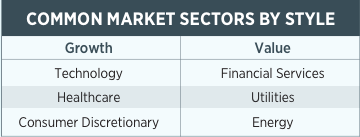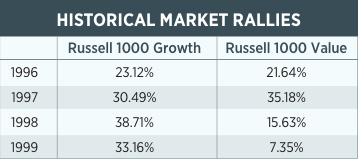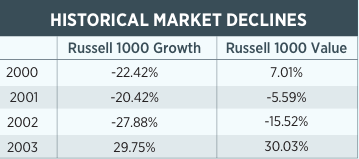When investors compare equity investment funds, they are categorized as having a “growth-style” or “value style.” Although these funds may invest in similar companies, their approach toward identifying securities is different.
Growth-fund managers tend to focus on companies they believe will have faster-than-average growth in revenue, earnings and cash flow. Fund managers will look at how the company is managing its earnings; for example, are they continuing to reinvest earnings in new projects? Facebook, Amazon and Pfizer tend to be commonly held stocks in growth funds. These funds focus more on younger companies that reinvest their earnings back into the company to achieve continued growth.
Value-fund managers tend to focus more on mature companies they believe are undervalued. The reasons for the perceived low value can vary, and range from a temporary shock in the company’s earnings to a weakness in the industry. Coca-Cola, Procter & Gamble and General Electric are common stocks held in value funds.
TRENDS ACROSS MARKET SECTORS
As a result of these style distinctions, a trend has emerged where fund managers tend to focus more heavily on specific sectors:
Growth-style managers often choose to overweight market sectors such as technology and healthcare, sectors that are typically viewed as having more potential upside at the cost of greater volatility. Value-style managers often focus more on financial and utility-market sectors, typically viewed as having more stable and established companies. Keep in mind that these are general trends, not rules.
HOW HAVE THESE STYLES PERFORMED DURING VARIOUS ECONOMIC CYCLES?
Historically, the contest between growth and value has been practically even. Generally speaking, growth funds performed better in the ’90s, whereas value funds did better from 2000 to 2007. Since 2007, growth has again outperformed. Throughout this time period, however, growth has been more volatile, when measured by standard deviation.
Investors may find the most appropriate course of action is to diversify between value and growth with tilts during certain economic cycles.
As can be seen at right, we compared a growth index to a value index during a bull and bear market. Growth tends to perform better in up-markets; however the magnitude has been minimal. The conventional wisdom is that growth stocks should perform better during early-to-mid-economic cycles.
*Source: Morningstar Returns for: Russell 1000 Growth TR USD and Russell 1000 Value TR USD
Value funds tend to perform better when there are slowdowns or market underperformance. If economic growth has slowed or is stagnant, value funds tend to outperform growth. During declining markets, value investors expect to sacrifice some upside potential in order to preserve capital.
*Source: Morningstar Returns for: Russell 1000 Growth TR USD and Russell 1000 Value TR USD
Keep in mind that these trends are not guaranteed to occur each year. In 2015, a year generally viewed as having a weak market, growth outperformed value. It may have been more advantageous to own growth funds, despite the history of value funds performing better in that market condition.
Even with these identified trends, it is difficult, if not impossible, to determine which investment style will outperform for any given year. Investors may find that the most appropriate course of action is to diversify between value and growth, with tilts during certain economic cycles; however, it is always wise to speak with your financial advisor to discuss your overall portfolio asset allocation.
This article was originally published in the December 2016/January 2017 issue of Worth.



















